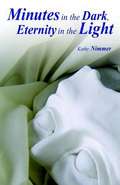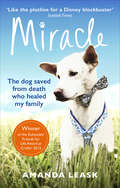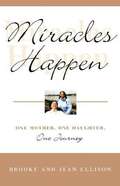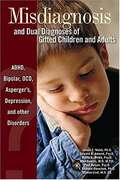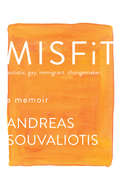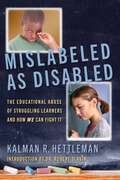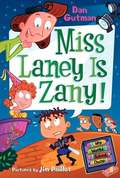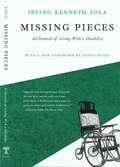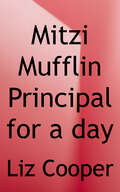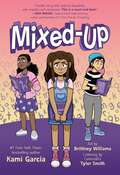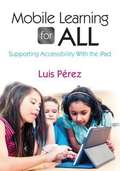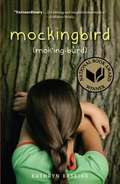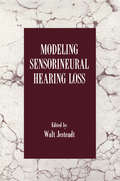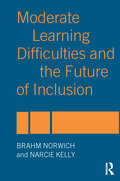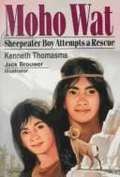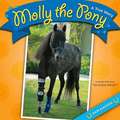- Table View
- List View
Minutes in the Dark, Eternity in the Light
by Kathy NimmerThis book contains 140 minute poems: short word pictures of the author's personal journey through vision loss. While every poem is anchored in the theme of blindness, the poems inexplicably rise above that disability label. Many poems are upbeat while others are quite sad. Some share incidents that are well-known by those in his world while others speak of things he has never communicated to another living soul. It is an honest collection of his life experiences tied to the decline of his sight.
Miracle
by Amanda LeaskAs seen on ITV's Britain's Got Talent, where they captured the hearts of the nation, this is Amanda and Miracle's incredible story of survival, love and hopeSnatched from the streets of Thailand, loaded onto a truck with hundreds of other stolen dogs and destined for the restaurants of Hanoi, Miracle the dog shouldn’t be alive today. But an incredible rescue led to a fateful meeting with Amanda Leask, a dog lover from Scotland. Devastated by Miracle’s plight and the hopelessness of his situation, she knew she had to do everything in her power to save him. But Amanda could never have imagined that in doing so she was really saving herself… Amanda’s six year-old son Kyle, who was born with cerebral palsy and autism, built a deep and lasting connection with Miracle and their special bond has transformed not only Kyle’s life but that of the entire family. Heartbreaking, inspirational and ultimately life-affirming, this incredible tale is proof that miracles really can happen…
Miracle Moments: Helping the Rescued Become the Rescuers
by Renee Vajko Srch<p>Inspiring stories of how both people and dogs with the odds stacked against them give each other a new start in life from the founder of Dog’s Nation.<p> <p>When Shawn Abell founded Dog’s Nation, her purpose was to save dogs and train them as service dogs for individuals with Autism Spectrum Disorder or veterans suffering from Post-Traumatic Stress Disorder. In pairing these dogs with individuals with special needs, Dog’s Nation ultimately saves two lives instead of just one.<p> <p>Miracle Moments offers readers the opportunity to meet some of the special animals Dog’s Nation has rescued. There’s Jack who gently coaxed a veteran with PTSD out of the darkness where he’d been living for so long; Max, a scruffy little terrier who brought emotional healing to a girl with autism; Amy, a terrier-mix who averted a near-drowning; Charm, a golden retriever who gave an autism family a new lease on life; and so many more true stories that will inspire and warm your heart.<p>
Miracle in the Making: The Adam Taliaferro Story
by Scott Brown Sam CarchidiOn September 23, 2000, Adam Taliaferro had a lot going for him. He was a promising young football player on a full scholarship at Perm State University who seemed to have a career in the NFL in front of him. But after a jarring hit on an Ohio State running back, he woke up flat on his back in a hospital, unable to feel anything below his neck. His doctors said he would probably never walk again. Determined to prove those doctors wrong, Adam and his family embarked on a courageous journey of determination and faith that would end with Adam walking on his own two feet once again. Miracle in the Making is the remarkable story of that courageous achievement over incredibly long odds. It's the story of a recovery called miraculous by his doctors-a story of tragedy and triumph, of hope and inspiration, and a story that will remain with the reader long after the final page is turned.
Miracles Happen: One Mother, One Daughter, One Journey
by Brooke Elison Jean ElisonAt age eleven, Brooke Elison was hit by a car on her way home from school. As a result, she was permanently paralyzed. This is her memoir, and also the story of Jean Elison, her mother, who worked tirelessly to ensure that Brooke would be a successful woman. This story chronicles their lives over the ten years following the accident, telling of countless trials and triumphs, ending when Brooke graduated from Harvard.
Miracles Happen: One Mother, One Daughter, One Journey
by Brooke Ellison Jean EllisonBrooke Ellison was the victim of an automobile accident that left her paralyzed from the neck down when she was eleven years old. Written with her mother, Jean, her closest companion, Brooke's story starts on the day that changed her life. This inspiring story is not just about one person, but about the heroics of a family.
Miracles of Mind: Exploring Nonlocal Consciousness and Spiritual Healing
by Russell Targ Jane KatraFrom the Table of Contents: chapter one The Illusion of Separation A Physicists Description of His Psi Experiences chapter two Our Astonishing Nonlocal Mind CIA Spying at SRI Yields Unequivocal Proof of TSP. chapter three What We Have Learned about Remote Viewing How You Can Learn to Do It Yourself chapter four The Masters of the Universe and the Mystery of Psi The Golden Experiments in Psi from This Century chapter five Precognition: Time and Time Again What Does It Mean to Look into the Future chapter six Are Psychic Abilities Using Psychic Abilities in the World, Including Spiritual Healing chapter seven The Making of a Healer Becoming a Healer Cosmic Consciousness, Mystical Experiences chapter eight The Healing Experience Mind-to-Mind Connections: Jane's Healing Experiences Chapter nine Minding the Body Significant Mind-Body Experiments and Distant Influence chapter ten Ways of Healing Spiritual and Energy Healing, Therapeutic Touch, Diseases chapter eleven a Prayer and the Healing Connection Healing Prayer Love and Surrender How to Do Spiritual Healing chapter twelve The Physics of Miracles and the Magic of Mind A Theory of Unity Consciousness and Hope for the Future The book also include an extensive bibliography.
Mirror Dance (Miles Vorkosigan #8)
by Lois Mcmaster BujoldIt's not easy dying. Coming back to life is even harder. Miles, Mark, and the Dendarii get tangled up in Jackson's Hole politics, with disastrous results.<P><P> The exciting follow-up to Brothers in Arms. Miles Vorkosigan is in trouble. His brother, a cloned stranger formed from tissue stolen from Miles when he was a child, wants to murder and replace him. Unfortunately, Mark has learned that without Miles, he is... nothing.<P> Hugo Award winner.
Misdiagnosis and Dual Diagnoses of Gifted Children and Adults
by James Webb Edward R. Amend Nadia E. Webb Jean Goerss Paul Beljan F. Richard OlenchakDescribes how to guard against misdiagnosing gifted children and adults, and how to treat gifted persons with and without dual diagnoses.
Misfit: autistic. gay. immigrant. changemaker.
by Andreas SouvaliotisUpdated and expanded: A new edition of the inspiring memoir by one of Canada's most unusual, successful and socially conscious businesspeople."I am different. I have always been different. I grew up scared of being found out, scared of my natural inability to fit in, to conform, to look and sound and dress and behave 'normal.' I was always drawn to the different ones and I observed them with fascination--but the thought of being even a little bit like them mortified me. I was desperate to fit in. . . ." --From MisfitAndreas Souvaliotis was raised at a time when being on the autism spectrum wasn't easily diagnosed or even discussed. Minds like his were simply considered odd. He also knew from an early age he was gay, and it terrified him as he was growing up with openly homophobic parents in one of Europe's least tolerant societies.Andreas's differences made him an outsider, right through to his mid-forties. And then suddenly, everything changed. Misfit is the extraordinary memoir of a man who realized there was strength in his strangeness, that it could be used as a force for good. "It all happened in a flash. On a beautiful spring morning in 2007, sitting in my backyard and licking my wounds from a spectacular career derailment, I came up with a big idea--and I found myself contemplating the most daring and unconventional pursuit of my life." The weird kid from Greece was on his way to making his world, and everyone's world, a better place.Andreas Souvaliotis's inspiring story shows us that everyone has what it takes to trigger positive change, and that none of us should see our differences and quirks as handicaps.
Mislabeled as Disabled: The Educational Abuse of Struggling Learners and How WE Can Fight It
by Kalman R. HettlemanKalman R. &“Buzzy&” Hettleman exposes the educational abuse suffered by tens of millions of struggling learners, including many who are &“Mislabeled as Disabled&” and dumped into special education. The majority of these students are not disabled in any medical or other clinical sense. Rather, in violation of federal law, they fail to receive proper instruction and fall farther behind, suffering stigma and segregation. Hettleman also shows how teachers are undervalued heroes denied the teaching tools to do the job right and, like students, are victimized by the system. This book is a call to everyone to become enraged, and then engaged in the struggle for reform.
Miss Laney Is Zany (My Weird School Daze #8)
by Dan GutmanThe weirdness never stops! A. J. has to go see Miss Laney, the speech teacher, which makes no sense at all because he already knows how to talk. Miss Laney has him say weird tongue twisters and forces him to be the lead in the third-grade play, Romeo & Juliet. And you'll never guess in a million hundred years who's going to play Juliet. Will there be kissing? Ew, disgusting!
Missing Pieces: A Chronicle of Living With a Disability
by Irving Kenneth Zolahe personal odyssey of a man with a disability, this passionate book tries to tell as well as analyze what it is like to have a disability in a world that values vigor and health. Zola writes, "Missing Pieces is an unraveling of a social problem in the manner of Black Like Me. Like its author, I, too, am a trained social observer, but for me 'passing' was not an issue. For I already have the stigmata of the disable - the braces, the limp, the cane - though I have spent much of my life denying their existence." The author started out in the role of a social scientist on a seven-day excursion to acquaint himself with an extraordinary experiment in living - Het Dorp, one of the few places in the world designed to promote "the optimum happiness" of those with severe physical disabilities. Neither a medial center nor a nursing home, Het Dorp is a village in the western-most part of the Netherlands. What began as a sociological attempt to describe this unusual setting became, through the author's growing awareness, what can only be called a socio-autobiography. Resuming his prior dependence on a wheelchair, the author experienced his own transformation from someone who is "normal" and "valid" to someone who is "invalid." The routine of Het Dorp became his: he lived in an architecturally modified home, visited the workshops, and shared meals, social events, conversation, and perceptions with the remarkably diverse residents. The author confronts some rarely discussed issues - the self-image of a person with a chronic disability, how one fills one's time, how one deals with authority and dependence, and love and sex. Missing Pieces offers striking insights into an aspect of the human condition shared by nearly 30 million Americans. It is must reading for the general reader, as well as for the rehabilitation counselor, social worker, or social scientist. Author note: Irving Kenneth Zola (1935-1994) was Professor of Sociology at Brandeis University and a founding member and counselor at the Boston Self-Help Center. Nancy Mairs is the author of seven books, including Waist-High in the World: A Life Among the Disabled, and most recently, A Troubled Guest: Life and Death Stories. She lives in Tucson with her husband, George.
Mitzi Mufflin: Principal for a Day (The Potts-Abilities)
by Liz CooperWhen new student Mitzi Mufflin, who happens to be blind, joins the gang at Mortimer Potts Elementary School, she’s thrilled to named Principal for a Day. Little does she know, the real principal and teachers will disappear! <p><p>Can Principal Mufflin and her pint-sized “staff” secretly run the school until the teachers return? Join Mitzi as she navigates her way through each new challenge to save the school from disaster, using resourcefulness, determination, and her cane, Tappity. Mitzi is confident in her abilities. She proves to us all, that if everyone were exactly the same, it would be a very boring world. <p><p>This book is the second in a series by Liz Cooper featuring resilient young characters dealing with unique challenges.
Mixed-Up
by Kami GarciaNew York Times bestselling author Kami Garcia has returned with a middle grade graphic novel about the struggles of a game-loving girl who gets diagnosed with dyslexia and her loving support network that help her along in the journey.Stella knows fifth grade will be the best year ever. Her closest friends, Emiko and Latasha, are in her class and they all got the teacher they wanted. Then their favorite television show, Witchlins, announces a new guidebook and an online game!But when the classwork starts piling up, Stella struggles to stay on top. Why does it take her so long to read? And how can she keep up with friends in the Witchlins game if she can’t get through the text-heavy guidebook? And when she can’t deal with the text-heavy Witchlins guidebook, she can’t keep up with her friends in the game. It takes loving teachers and her family to recognize that Stella has a learning difference, and after a dyslexia diagnosis she gets the support and tools she needs to succeed.Bestselling author Kami Garcia was inspired to write this special book by her daughter’s dyslexia journey; her own neurodivergent experience; and the many students she taught over the years. With subtle design and formatting choices making this story accessible to all readers, Mixed-Up shows that our differences don’t need to separate us.To make reading as comfortable as possible for dyslexic readers, the book has been lettered in Dyslexie.Praise:“Mixed-Up is sweet, fun, and important—a cozy blanket for those of us with learning differences. I wish I'd had this book when I was growing up with dyscalculia." — Hope Larson, New York Times bestselling & Eisner-winning cartoonist of A Wrinkle in Time and All Summer Long“Mixed-Up carefully and gently discusses the frustrations and struggles of a child living with dyslexia and handles it beautifully with empathy and compassion. This is a must read book.” —Dan Santat, National Book Award winner and bestelling author and illustrator of A First Time for Everything“Here’s what I love about this middle grade graphic novel: The pacing, the length—just perfect—the easter eggs, the magic, and Brittney Williams’ art. Kami Garcia has written a very beautiful story about dyslexia, with a very important message about courage.”—Kwame Alexander, Emmy Award-winning producer and #1 New York Times bestselling author of The Crossover and The Door of No Return.
Mixing Magics (Accidental Demons)
by Clare EdgeYoung witch Ber uncovers buried secrets tying her family&’s coven to the demon dimension in this sequel to Accidental Demons, perfect for fans of Witchlings and Aru Shah and the End of Time! Bernadette Crowley feels like she&’s finally getting a handle on her diabetes diagnosis. At least, she can finally manage to not summon a demon every time she checks her blood sugar. But without her Grandma Orla, who disappeared into the demon dimension while protecting their family&’s coven, even big wins don&’t seem to matter as much. Frustrated that no one is trying hard enough to rescue Grandma Orla, Ber takes matters into her own hands, using her growing powers to try to reach the demon dimension. But nothing can prepare her for the truth, a history that ties together her family and demons back generations and a betrayal that has haunted them for years. With her friends Cai and Phoebe and her alert dog Clio, Ber must venture into the unknown to save her grandma and the magical world as a whole.
Mobile Learning for All: Supporting Accessibility With the iPad
by Luis PérezThis book provides practical information for teachers and other educational professionals who want to learn how to use the iPad to meet the needs of all learners.
Mobility Training for Visually Handicapped People: A Person Centered Approach
by Allan DoddsThis is one of the first works to begin formalizing the structured discovery method of O&M instruction.
Mockingbird
by Kathryn Erskine<P>Caitlin has Asperger's. The world according to her is black and white; anything in between is confusing. <P>Before, when things got confusing, Caitlin went to her older brother, Devon, for help. But Devon was killed in a school shooting, and Caitlin's dad is so distraught that he is just not helpful. <P>Caitlin wants everything to go back to the way things were, but she doesn't know how to do that. Then she comes across the word closure--and she realizes this is what she needs. <P>And in her search for it, Caitlin discovers that the world may not be so black and white after all.<P><P> <b>Winner of the National Book Award</b>
Modeling Sensorineural Hearing Loss
by Walt JesteadtA recent study indicates that 20 million people in the United States have significant sensorineural hearing loss. Approximately 95% of those people have partial losses, with varying degrees of residual hearing. These percentages are similar in other developed countries. What changes in the function of the cochlea or inner ear cause such losses? What does the world sound like to the 19 million people with residual hearing? How should we transform sounds to correct for the hearing loss and maximize restoration of normal hearing? Answers to such questions require detailed models of the way that sounds are processed by the nervous system, both for listeners with normal hearing and for those with sensorineural hearing loss. This book contains chapters describing the work of 25 different research groups. A great deal of research in recent years has been aimed at obtaining a better physiological description of the altered processes that cause sensorineural hearing loss and a better understanding of transformations that occur in the perception of those sounds that are sufficiently intense that they can still be heard. Efforts to understand these changes in function have lead to a better understanding of normal function as well. This research has been based on rigorous mathematical models, computer simulations of mechanical and physiological processes, and signal processing simulations of the altered perceptual experience of listeners with sensorineural hearing loss. This book provides examples of all these approaches to modeling sensorineural hearing loss and a summary of the latest research in the field.
Moderate Learning Difficulties and the Future of Inclusion
by Brahm Norwich Narcie KellyChildren with mild to moderate learning difficulties (MLD) make up the largest sub-group of children requiring special educational needs, and yet they are often neglected in terms of research and in their influence on future Government policies. This book, based on a Nuffield Foundation research project, considers the perspectives of children with moderate learning difficulties, reviewing relevant issues such as:* identification of children with MLD;* appropriate curriculum and pedagogy;* inclusion in mainstream schools; * their identity and self-perception.The authors weave their findings into a wider review of current research in the MLD field and use a range of perspectives, from the professional, to psychological and sociological.This is a contemporary look at MLD that discusses the historical and policy context , origins and justification for having a category for MLD. Students, researchers, and academics that are active in the field of inclusive education will find this an insightful and comprehensive text.
Modular Instruction for Independent Travel for Students Who Are Blind Or Visually Impaired: Preschool Through High School
by Doris M. Willoughby Sharon L. MontheiModular Instruction For Independent Travel For Students Who Are Blind Or Visually Impaired: Preschool Through High School is a flexible, practical guide for teaching cane travel to students of preschool age through high school.
Moho Wat: Sheepeater Boy Attempts a Rescue (Amazing Indian Children Ser. #6)
by Kenneth ThomasmaMoho Wat is from the Sheepeater tribe that lives in the mountains of what is now Yellowstone Park. Life is hard for the nine-year-old after a terrible struggle with a mountain lion causes him to lose his left hand. Although devastated, Moho Wat struggles to overcome his injury and teach himself to hunt--using his feet to hold the bow and arrow. His courage and strength is tested when he attempts to rescue the beautiful Wind Flower, who has been taken captive by an enemy tribe. Moho Wat realizes he has succeeded when his father says, "My son, today you have proved that you are as good as any man. You have shown your bravery and your goodness. I am proud of you my son, Moho Wat." Author Kenneth Thomasma is a professional storyteller and writing workshop leader living in Jackson Hole, Wyoming. Moho Wat is the sixth book in his series, "Amazing Indian Children." More of the books in the Amazing Indian Children series are in Bookshare's library. Look for Naya Nuki Shoshoni Girl Who Ran, Om-kas-toe Blackfoot twin captures Elkdog and Pathki Nana Kootenae Girl Solves A Mystery.
Mojo The Blind Friesian
by Laura BeemanThis is the true story of Mojo a blind friesian horse who overcame many obsticles to become a member of a quadrille. He used his other senses to move around his environment.
Molly The Pony: A True Story
by Pam KasterMolly the pony waits. She waits in her stall. She waits during the storm. She waits for her owner to return. So begins the true story of a patient pony who is rescued from a south Louisiana barn after Hurricane Katrina and finds a new life on a farm with new animal friends. But Molly's tale of courage does not end here. When a dog on the farm attacks Molly, her front leg is badly injured. For a pony, a damaged leg is life threatening. To the amazement of veterinarians, though, Molly rises to her new challenge. She undergoes a rare surgery for horses: amputation of her front leg. Now fitted with a prosthetic limb, Molly relearns how to walk and embarks again on a new mission in life: making new people friends. This plucky pony's story of survival and friendship will win the hearts of readers young and old. All who have had to start over after displacement, abandonment, injury, or amputation will find a friend in Molly as they follow her story of bringing a smile to everyone she meets.
